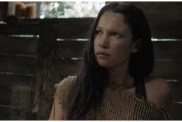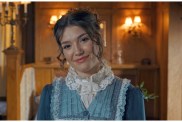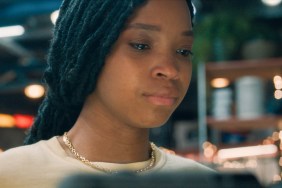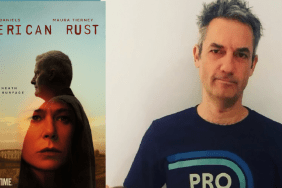
Meet del Toros concept team. I have a very, very small group of designers, same as in all of the movies. We basically have four concept guys, and the four concept guys [are] next to my office and we designed all of the concepts, the core group, about six months. One or two of them stayed until we started photography, still designing. I mean, we designed every prop that was built. We designed all the graphics because normally, a period movie a lot of times has problems with the graphics. They look modern made and I really wanted everything to feel authentic so we have a newspaper from a murder that is done in the style of the lurid newspapers of the 1800s, with an engraved feeling. It has the exact feeling of like, that Jack the Ripper spread.
Before building the house on set, production designer Thomas E. Sanders made del Toro a highly precise model of it. Normally we do these guys in white foam and foam work and Tom, who’s a fantastic designer. He said, well [draw] everything. And I normally go from the drawings to the foam work to the set. And he said, You know, it would be great if we can build the model. And, you know, he did that for Braveheart, on Private Ryan, and this and that. He got me with the f*cking resume so we built 3D. And, you know, it’s really quite disturbing how accurate it is, you know? When you look at the house, you’ll see how accurate it is to this.
The head set painter gets in on the model-making, too. Our head set painter, painted the models first, so he just ended up painting a larger model than the first one.The house will oppress the characters more and more throughout the movie. What it is is the house becomes more and more alive. I’m very careful when I introduce the house to introduce it as a single space, but the more we stay in the house, the more I encroach the characters and the architecture.
The house will become more and more human throughout the movie. That is a progression in the house, the way the house starts breathing or sounding, with Randy Thom, our sound designer, and the way the house sounds is more and more human as the movie progresses.
The house literally decays. What we said is, we need to have the house feel a little bit like an organism. There was a line that I already cut in the editing room where it says it lays down like an animal and it goes slowly mad. The house in the screenplay and in the movie has certain features that make it seem [like] a living organism, and so it’s decaying. It’s sitting in the middle of a field, rotting. So we knew that the top needed to be sort of the most weathered part of the house. The bottom and the areas where you would receive visitors or live are slightly more kept.
Mother Sharpe is responsible for it all, but will only appear in the film in a portrait hanging in the living room. This is the guilty party of everything that happens. Discussing the actual painting, del Toro explained, The photo of the lady was taken by David Cronenberg’s daughter and that’s what we based the light on. He added, This is a very typical pose of a landowner portrait in Victorian portraiture. The cameo on her neck is the cameo that was my grandmothers, and its the cameo that is [in] The Devil’s Backbone on the character of Marisa Paredes, and its the cameo that Jessica wears. And the ring on her finger [is] the ring that Thomas gives Mia as an engagement ring when theyre gonna marry.
The house has a working elevator. I refuse to do green screen on the elevator. I wanted the actors to really go from the top to the bottom Literally, we weighed the cameraman, the steadicam, the heaviest lens, the focus puller, the actress and the dog, and that’s the permit. Because, you know, to ride with four or five people, you really need to be able to – we didnt want to risk it, so one of the rules is nobody rides the elevator for fun, which made this a f*cking Victorian StairMaster for me [laughs].
Some of the house is going home with del Toro. I pay 50% of the prop and then I keep it. When a prop is, how do you say, controversial with the studio, if it’s too expensive, I go, ‘I’ll pay half, and then I’ll keep it.’ And that’s how the house was built, on splurge because, in reality, when they auction them, they auction them for very little Im keeping the portrait, probably the balcony. [Laughs] Im still trying to resist. The crest, the automaton, the model of the machine of Thomas, theres a steam engine, a couple of pieces of furniture and four books that I found. I found four books in the library that I like.
Del Toro writes libraries in his movies so he can take from the books needed to dress the set. I write libraries in order to explore what books come in. Like out of Hellboy 1, I got a collection of The Strand magazine.
The America sets are in direct contrast to the house set. The way we call it in the movie, America is old tobacco – gold and green. It’s like lush and literally feels like wealth, like optimism, like turn-of-the-century America where everything was blooming. And the old world and here is all blues and grays, really deep browns. It’s very dark. Its very bleak. So when you shoot in America, you have huge beams of sunlight in the windows, you have very vivid sunlight. It’s faster in a way. In the interior here, you’re still lighting a lot from the floor.
What types of scares can you expect? “There’s a couple of strong moments that are very, very graphic, but they are done just to punctuate, you know? I remember when I showed Pans Labyrinth in the beginning, somebody said to me, You know, the movie would make much more money without the bottle scene. And I said, Yeah, but it wouldnt be the same movie, so this is punctuated a little like that. Like, there are about three or four moments thatll have you go, Ooh! Thats nice. Thats brutally nice. [Laughs]









